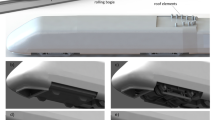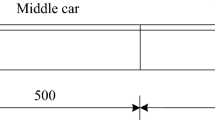Abstract
The present study assesses the applicability of towing tank experiments using a moving model for the investigation of the aerodynamics of long land-borne heavy vehicles such as buses, trucks, and trains. Based on experiments with a 1:22 scaled model of a high-speed train, the influence of various conditions relevant for the transferability of the results obtained in water to air is analysed exemplarily. These conditions include surface waves, cavitation and submergence depth. The experiments were carried out in the shallow water towing tank of the Technische Universität Berlin. It is shown that outside a critical Froude number range of about 0.2 < Fr < 1.2 the impact of the surface waves can be neglected and no cavitation appears in the velocity range investigated. Furthermore, a correction method is proposed taking into account the bias through surface waves at small submergence and thus allowing for a wider Froude number range. The data obtained in the towing tank are found to be in excellent agreement to other investigation methods.
Graphical abstract






















Similar content being viewed by others
Notes
According to Barlow, the pressure gradient in a closed square jet with width B can be calculated depending on the distance ΔL using cp(ΔL)= − k ΔL/B. The factor k has been observed in the range of 0.016–0.04. For the plot shown in Fig. 14, B = √8 (same cross-section area as in the towing tank) and k = 0.016 were used. The choice of the lower limit k value considers the normally optimized shape of the test section regarding boundary layer growth. However, the appearance of blockage effects both in closed and open test sections might impose additional pressure gradients that were not considered here.
References
Airy GB (1845) Tides and waves. Encycl Metrop 192:241–396
Aoki K, Miyata H, Kanai M, Hanaoka Y, Zhu M (1992) A waterbasin test technique for the aerodynamic design of road vehicles. SAE technical paper (920348), pp 163–181. https://doi.org/10.4271/920348
Baker CJ (1986) Train aerodynamic forces and moments from moving model experiments. J Wind Eng Ind Aerod 24:227–251
Baker CJ, Gilbert T, Jordan S (2013) The validation of the use of moving model experiments for the measurement of train aerodynamic parameters in the open air. In: Proceedings of the 10th world congress on rail research, Sidney, 25th–27th November 2013
Barlow JB, Rae WH, Pope A (1999) Low-speed wind tunnel testing. Wiley, New York
Brennen CE (2005) Fundamentals of multiphase flows. Cambridge University Press, Cambridge. ISBN 0521 848040
Brockie NJW, Baker CJ (1990) The aerodynamic drag of high speed trains. J Wind Eng Ind Aerod 34:273–290
CEN European Standard (2010) EN 14067-6:2010-05 railway applications—aerodynamics—part 6: requirements and test procedures for cross wind assessment. Technical report
CEN European Standard (2013) EN 14067-4:2013 railway applications—aerodynamics, part 4: requirements and test procedures for aerodynamics on open track. Technical report
Clauss G, Lehmann E, Östergaard C (1992) Offshore structures. Springer, Berlin
Erickson GE, Peake DJ, Del Frate J et al (1986) Water facilities in retrospect and prospect—an illumination tool for vehicle design. NASA technical memorandum 89409
Fischer D, Tschepe J, Nayeri CN, Paschereit CO (2018) Partially-averaged Navier–Stokes method for train aerodynamics. In: Proceedings of the 3rd international symposium of rail aerodynamics and train design, Berlin, 30–31 January 2018
Gad-el Hak M (1987) The water towing tank as an experimental facility. Exp Fluids 5(5):289–297. https://doi.org/10.1007/BF00277707
Gertler M (1950) Resistance experiments on a systematic series of streamlined bodies of revolution. Navy Department, The David W. Taylor Model Basin, Washington
Havelock TH (1908) The propagation of groups of waves in dispersive media, with application to waves on water produced by a travelling disturbance. Proc R Soc 89(613):430–446
Heine D, Ehrenfried K (2012) Experimental study of the entry of a high-speed train into a railway tunnel. Int J Railw Technol 1:1–18
Hensen W (1955) Modellversuche für den Hafen Acajulta. Jahrb Hafenbautechnischen Ges 23/24:38–76
Hoerner SF (1965) Fluid-dynamic drag. Hoerner fluid dynamics, Bakersfield
Howe MS, Iida M, Fukuda T, Maeda T (2003) Aeroacoustics of a tunnel-entrance hood with a rectangular window. J Fluid Mech 487:211–243. https://doi.org/10.1017/S0022112003004725
Hucho WH (2011) Aerodynamik der stumpfen Körper. Vieweg + Teubner, Wiesbaden
Inui T (1954) Japanese developments on the theory of wave-making and wave resistance. Trondheim OCLC 246326540
Jagadeesh P, Murali K (2010) RANS predictions of free surface effects on axisymmetric undetwater body. Eng Appl Comput Fluid 4(2):301–313. https://doi.org/10.1080/19942060.2010.11015318
Jönsson M, Wagner C, Loose S (2012) Underfloor flow measurements of 1:50 generic high-speed train configurations for different ground conditions in a water towing tank. Int J Railw Technol 1:85–113
Jönsson M, Wagner C, Loose S (2014) Particle image velocimetry of the underfloor flow for generic high-speed train models in a water towing tank. Proc Inst Mech Eng F J Rail Rapid Transit 228(2):194–209. https://doi.org/10.1177/0954409712470607
Kwon H, Park Y, Lee D, Kim M (2001) Wind tunnel experiments on Korean high-speed trains using various ground simulation techniques. J Wind Eng Ind Aerod 89:1179–1195
Larsson L, Raven HC (2010) Ship resistance and flow. The Society of Naval Architects and Marine Engineers, Jersey City
Larsson L, Hammar L, Nilsson LU, Berndtsson A, Knutson K, Danielson H (1989) A study of ground simulation-correlation between wind-tunnel and water-basin tests of a full-scale car. SAE technical paper (890368), pp 421–445. https://doi.org/10.4271/890368
Mansoorzadeh S, Javanmard E (2014) An investigation of free surface effects on drag and lift coefficients of an autonomous underwater vehicle (AUV) using computational and experimental fluid dynamics methods. J Fluids Struct 51:161–171. https://doi.org/10.1016/j.jfluidstructs.2014.09.001
Mayer W, Wiedemann J, Neubeck J (2002) Fahrwiderstandsbestimmung im realen Fahrbetrieb. ATZ 104(5):484–491
Molland AF, Turnock SR, Hudson DA (2011) Ship resistance and propulsion: practical estimation of ship propulsive power. Cambridge University Press, Cambridge
Neppert H (1981) Böenbeeinflussung schnellfahrender Züge. ZEV Glas Ann 105(2):43–53
Neppert H, Sanderson R (1974) Untersuchungen zur Schnellbahn-Aerodynamik. Z Flugwiss 22(10):347–359
Neppert H, Sanderson R (1976) Böenbeeinflussung schnellfahrender Züge. Z Flugwiss 24(3):151–161
Neppert H, Sanderson R (1977) Vergleich zwischen Modell- und Originalmeßergebnissen sowie der Theorie zur Schnellbahn-Aerodynamik. ZEV Glas Ann 101(4):97–102
Pope CW (1991) The simulation of flows in railway tunnels using a 1/25th scale moving model facility. In: Haerter A (ed) Aerodynamics and ventilation of vehicle tunnels. Elsevier, Brighton, pp 709–737
Rosenberger R, Herzog J (1993) Versuche mit dem Triebzug intercity experimental auf DB-Strecken. BZA München, München
Schmidt HJ, Woszidlo R, Nayeri CN, Paschereit CO (2017) Separation control with fluidic oscillators in water. Exp Fluids 58:106. https://doi.org/10.1007/s00348-017-2392-0
Somaschini C, Argentini T, Rocchi D et al (2018) A new methodology for the assessment of the running resistance of trains without knowing the characterisitics of the track: application to full-scale experimental data. Proc Iinst Mech Eng F J Rail Rapid Transit 232:1814–1827. https://doi.org/10.1177/0954409717751754
Stephens RG, Stevens PRRJ, Babinsky H (2016) A method for truck underbody aerodynamic investigation. SAE Int J Commer Veh 9(2):429–437. https://doi.org/10.4271/2016-01-9020
Tschepe J, Nayeri CN (2017) Aerodynamik im Wasserkanal: Bestimmung des Luftwiderstandes mit geschleppten Modellen. ETR 66(10):45–49
Tschepe J, Nayeri CN (2018) Untersuchungen zum Strömungswiderstand von Schienenfahrzeugen mit bewegten Modellen im Wasserschleppkanal. ZEVrail Glas Ann 142(4):124–131
Tschepe J, Fischer D, Nayeri CN et al (2018) Investigation of high-speed train drag with towing tank experiments and CFD. Flow Turbul Combust. https://doi.org/10.1007/s10494-018-9962-y
Wickern G (2001) On the application of classical wind tunnel corrections for automotive bodies. SAE technical paper 2001-01-0633. https://doi.org/10.4271/2001-01-0633
Wigley WCS (1953) Water forces on submerged bodies in motion. Trans Inst Nav Archit 95:268–279
Willemsen E (1997) High Reynolds number wind tunnel experiments on trains. J Wind Eng Ind Aerod 69–71:437–447. https://doi.org/10.1016/S0167-6105(97)00175-X
Wilson-Haffenden S, Renilson M, Ranmuthugala D, Dawson E (2010) An investigation into the wavemaking resistance of a submarine travelling below the free surface. In: Proceedings of PACIFIC, pp 370–379
Yang M, Du J, Li Z et al (2017) Moving model test of high-speed train aerodynamic drag based on stagnation pressure measurements. PLoS ONE. https://doi.org/10.1371/journal.pone.0169471
Zhang D, Liu ZP, Li YM (2002) Cavitation monitoring by means of acoustic approach. In: Advances in fluid modeling and turbulence measurements, pp 249–255. https://doi.org/10.1142/9789812777591_0030
Zhang L, Yang M, Liang X, Zhang J (2017) Oblique tunnel portal effects on train and tunnel aerodynamics based on moving model tests. J Wind Eng Ind Aerod 167:128–139. https://doi.org/10.1016/j.jweia.2017.04.018
Acknowledgements
The research presented was supported by the ZIM program and the BIT GmbH. The project was funded under Grant Number EP 141376 from the “Zentrales Innovationsprogramm Mittelstand (ZIM)” of the Federal Ministry of Economy and Energy, following a decision of the German Bundestag.
Author information
Authors and Affiliations
Corresponding author
Ethics declarations
Conflict of interest
The authors declare that they have no conflict of interest.
Rights and permissions
About this article
Cite this article
Tschepe, J., Nayeri, C.N. & Paschereit, C.O. Analysis of moving model experiments in a towing tank for aerodynamic drag measurement of high-speed trains. Exp Fluids 60, 98 (2019). https://doi.org/10.1007/s00348-019-2748-8
Received:
Revised:
Accepted:
Published:
DOI: https://doi.org/10.1007/s00348-019-2748-8




